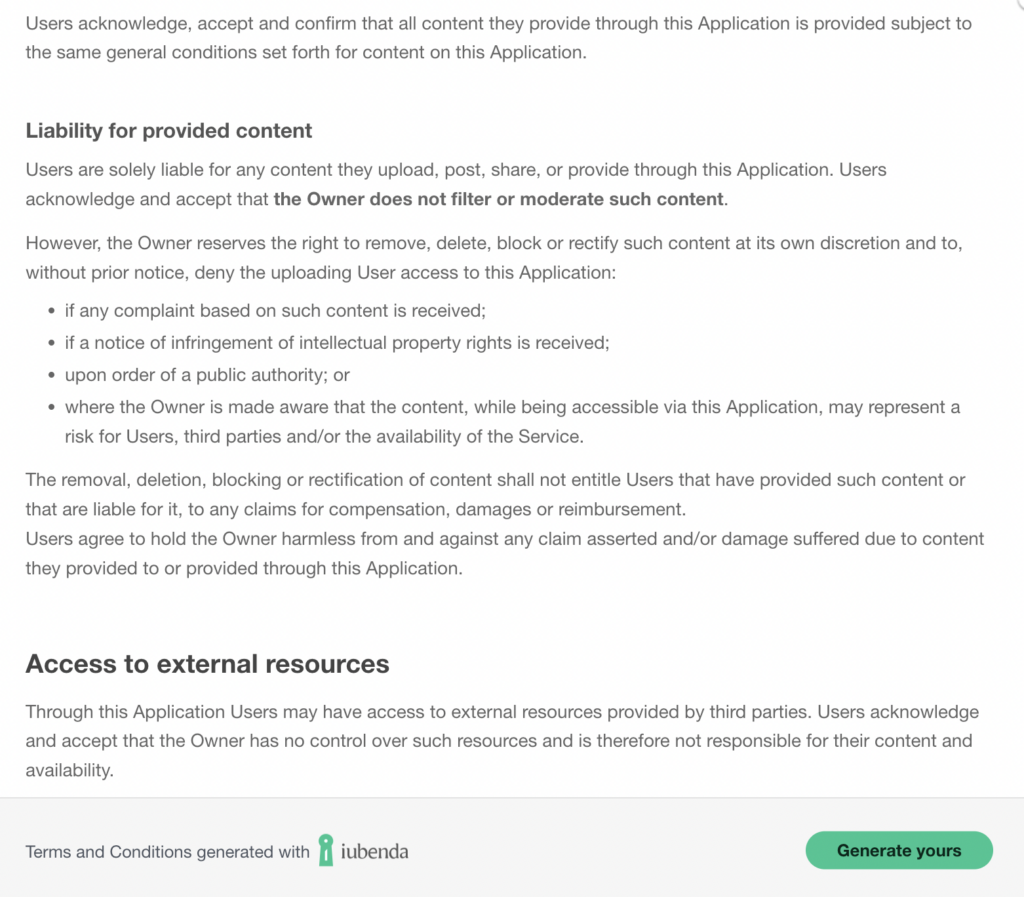“Terms and Conditions” is the document governing the contractual relationship between the provider of a service and its user. On the web, this document is often also called “Terms of Service” (ToS), “Terms of Use“, EULA (“End-User License Agreement”), “General Conditions” or “Legal Notes”.
The Terms and Conditions are nothing other than a contract in which the owner clarifies the conditions of use of its service. Some quick examples are the use of the content (copyright) , the rules that users must follow while interacting with one another on the website / app and, finally, rules related to the cancellation or suspension of a user’s account etc.
Particular emphasis should be given to the limitation of liability clauses (and disclaimers) , for example in cases of malfunctions of the app/ website, or user generated content. You can see an example of a Terms and Conditions clause below.

The Terms and Conditions therefore, represent the document that helps in dealing with problems or preventing them in the first place. Because of that, the Terms and Conditions are fundamental in many cases in order to mount an adequate and proper defense.
Terms of Service set the way in which your product , service or content may be used, in a legally binding way. They are crucial for protecting your content from a copyright perspective as well as for protecting you from potential liabilities.
Yes, it is not only advisable but also often mandatory.
Not only are terms critically important for protecting you from potential liabilities, but they regularly contain legally mandated information such as users’ rights, withdrawal or cancellation disclosures.
Generally, a website/app should have an accurate and valid Terms of Service document in place whenever complex issues are at stake, such as in the case of e-commerce, where sensitive information such as payment data is processed.
In e-commerce sites, the Terms of Service is typically the document that contains information related to conditions of sale and disclosures on methods of payment, shipping, delivery, withdrawals, and cancellation conditions etc. – as commonly required by consumer protection regulations.
💡 You can read more about eCommerce requirements here.
Creating this document for a website, app, or any other type of service can be complex and requires a comprehensive understanding of your business, legal requirements, and specific risk factors.. While the full content may vary based on the particulars of your business, your document should at least include the following basic information:
Remember the document must be up-to-date with all applicable regulations, precise, visible and easily understandable so that users can both easily see it and agree to it.
Despite how simple they appear, terms and conditions are meant to meet incredibly complex and highly specific scenarios. Because each terms and conditions document is a legally binding contract that is meant to protect you, the business owner, it’s imperative that the document matches your specific business processes, model, and remains up-to-date with the various laws referenced in its contents. Templates simply cannot do this, therefore, we strongly suggest that you avoid using templates. Read our extended answer to this question here.
They are such an important and legally-binding document that you should make sure they are professional and respect your business situation.
Without any legal background, it’s very complicated to write them on your own. That’s why it’s best to seek legal advice. Another strong and probably easier alternative, you can use a Terms and Conditions Generator. It allows you to build and generate your own document in a few clicks, and then install it on your website. Learn how to do this here.
In general, there is no legal difference. Terms and conditions, terms of service and terms of use are names all used to refer to the same document. The particular name used at any point in time is simply a matter of preference.
Privacy policy and terms and conditions are both legally binding agreements, but:
Customizable from over 100 clauses, available in 11 languages, drafted by an international legal team and up to date with the main international legislations, our Terms and Conditions Generator is capable of handling even the most complex, individual scenarios and customization needs.
Our solution works for businesses of any size, from the single blogger to enterprise level organizations, protecting their interests and their content.It’s optimized for e-commerce, marketplace, SaaS, mobile apps, blogs, publications and more.
read our guide on How to Generate a Terms and Conditions document.